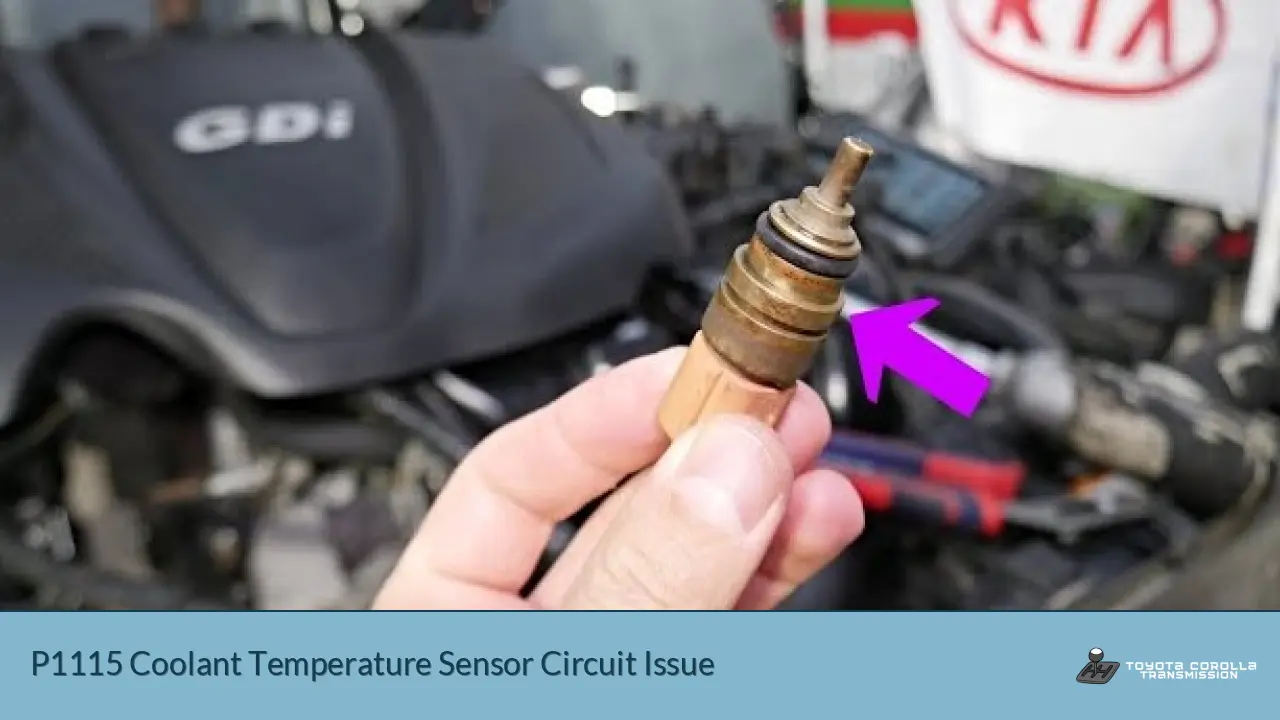The P1115 error code in Toyota vehicles indicates a problem with the coolant temperature sensor circuit for the heat storage system. This issue can lead to inaccurate temperature readings, potentially affecting engine performance and fuel efficiency. Let’s delve into the details of this fault code and explore its implications for your vehicle.
| Aspect | Description | Potential Impact |
|---|---|---|
| Definition | Intermittent high voltage in the Engine Coolant Temperature (ECT) sensor circuit | Incorrect temperature readings |
| Causes | Faulty sensor, wiring issues, PCM problems | Engine performance issues, reduced fuel efficiency |
| Symptoms | Check engine light, poor fuel economy, engine running too hot or cold | Decreased vehicle reliability, potential engine damage |
Understanding the ECT Sensor
The Engine Coolant Temperature (ECT) sensor plays a crucial role in your Toyota’s engine management system. It’s responsible for monitoring the temperature of the engine coolant and relaying this information to the Powertrain Control Module (PCM).
How the ECT Sensor Works
The ECT sensor contains a thermistor, which is a temperature-sensitive resistor. As the coolant temperature changes, the resistance of the thermistor changes accordingly. The PCM supplies a reference voltage (typically around 5 volts) to the sensor and monitors the voltage drop across the sensor. This voltage change corresponds to the coolant temperature.
The Role of the Heat Storage System
Toyota’s heat storage system is designed to retain engine heat after the vehicle is turned off. This stored heat can help with cold starts, reducing emissions and improving fuel efficiency in the initial stages of engine operation. The P1115 code specifically relates to the sensor circuit monitoring this system.
Causes of the P1115 Code
Several factors can trigger the P1115 code in your Toyota:
- Faulty ECT sensor: The sensor itself may be malfunctioning, providing incorrect readings to the PCM.
- Wiring issues: Damaged, corroded, or loose wiring in the ECT sensor circuit can cause intermittent high voltage readings.
- PCM problems: In rare cases, the PCM itself may be faulty, misinterpreting signals from the ECT sensor.
- Coolant issues: Low coolant levels or air pockets in the cooling system can affect sensor readings.
Symptoms and Consequences
When your Toyota experiences a P1115 code, you may notice:
- Illuminated check engine light
- Poor fuel economy
- Engine running too hot or too cold
- Rough idling or stalling
- Difficulty starting the engine, especially when cold
These symptoms can vary in severity, and in some cases, you may not notice any obvious signs of trouble beyond the check engine light.
Diagnosing and Fixing the P1115 Code
Addressing the P1115 code typically involves the following steps:
- Scan for additional codes: Other related codes may provide more context for the issue.
- Inspect the wiring: Check for any visible damage, corrosion, or loose connections in the ECT sensor circuit.
- Test the ECT sensor: Use a multimeter to check the sensor’s resistance at different temperatures.
- Check coolant levels: Ensure the cooling system is properly filled and bled of air.
- Replace components as necessary: Depending on the diagnosis, you may need to replace the ECT sensor, repair wiring, or in rare cases, replace the PCM.
Always consult your vehicle’s service manual or a professional mechanic for precise diagnostic procedures specific to your Toyota model.
Preventing Future Issues
To avoid recurring P1115 codes:
- Maintain proper coolant levels and quality
- Regularly inspect engine wiring for signs of wear or damage
- Address any cooling system issues promptly
- Follow Toyota’s recommended maintenance schedule
FAQs
What does the P1115 code mean for my Toyota?
It indicates an intermittent high voltage issue in the coolant temperature sensor circuit for the heat storage system. This can affect engine performance and efficiency.
Can I still drive with a P1115 code?
While you may be able to drive, it’s best to address the issue promptly to prevent potential engine damage or decreased fuel efficiency.
How much does it cost to fix a P1115 code?
Costs can vary widely depending on the underlying cause, ranging from $100 for a simple sensor replacement to $500 or more for complex wiring repairs.
Can a P1115 code clear itself?
While the code may occasionally clear itself, the underlying issue will likely persist and cause the code to return. It’s best to diagnose and address the root cause.
How often should I replace my Toyota’s ECT sensor?
There’s no set replacement interval. ECT sensors typically last the lifetime of the vehicle but can fail due to age or contamination.

